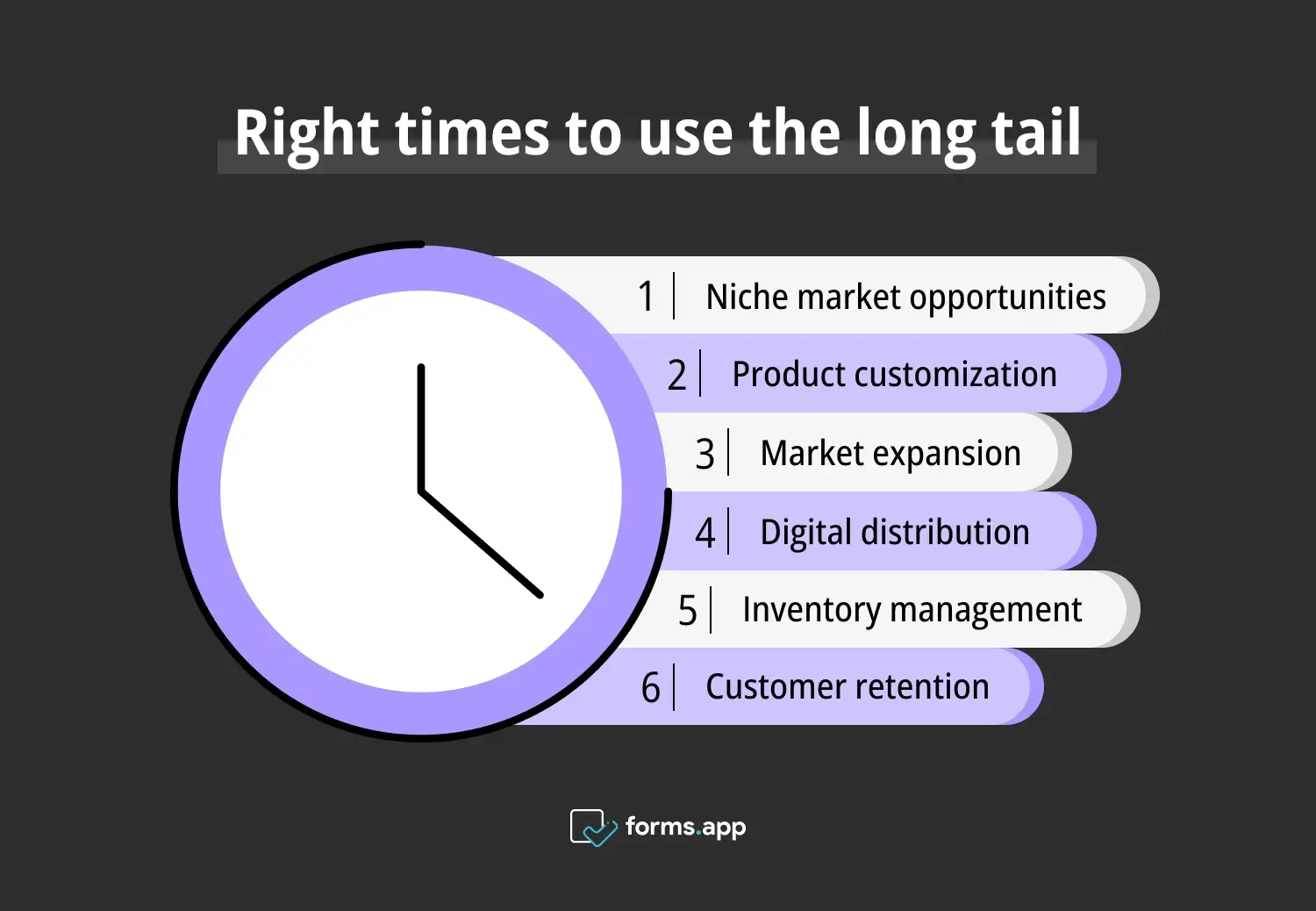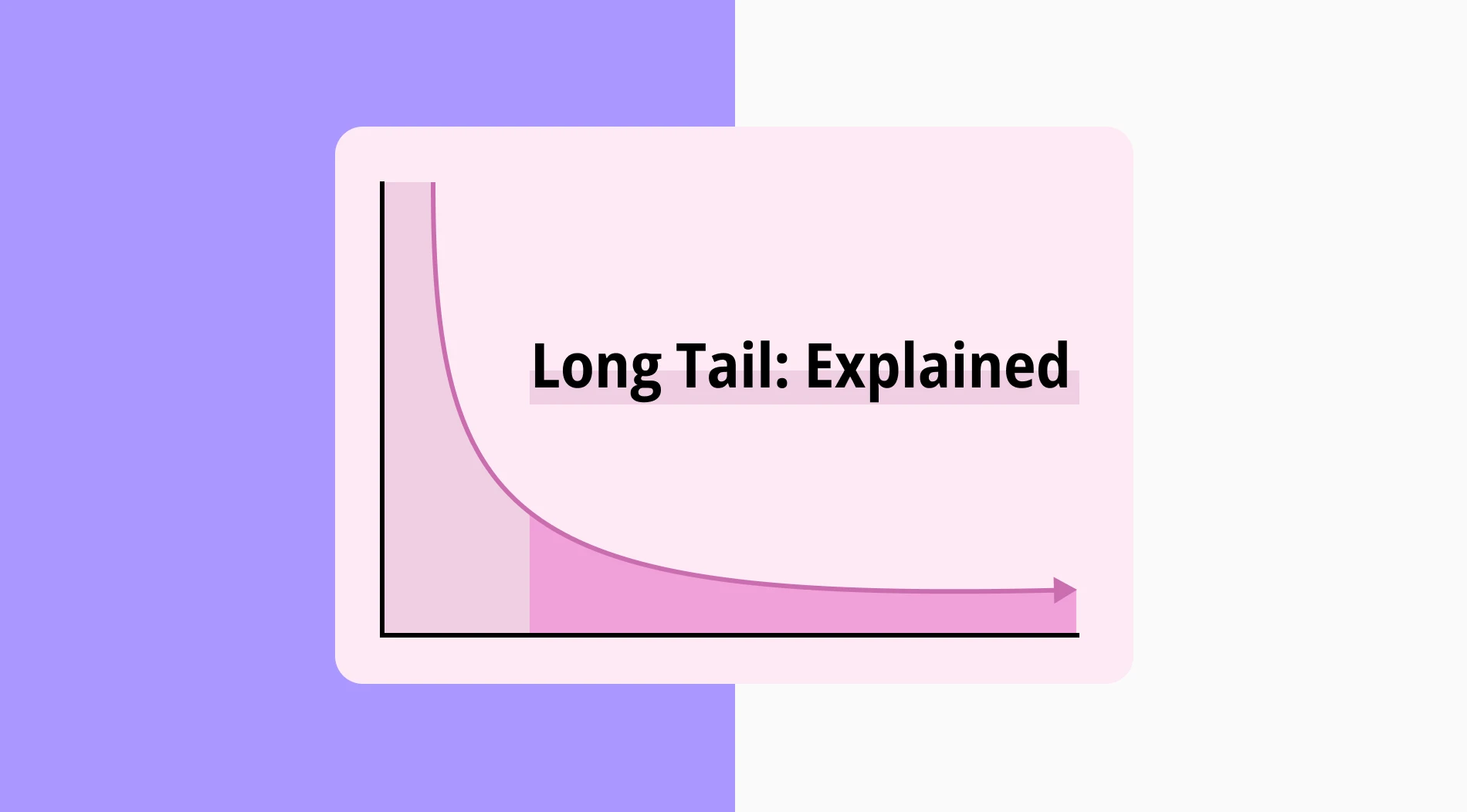In today's competitive digital landscape, knowing strategies for niche products and customer preferences is beneficial. With these, businesses can avoid the complexities of modern markets. These models represent a fundamental change in how businesses engage with their audience. They offer the promise of exponential growth and success in wide competition.
This full guide will take you on a journey through the Long Tail strategy. We will look at how to use this strategy effectively. You will also see nuances, suitable environments, and reasons to use it. With the examples and frequently asked questions, you will ensure your business becomes successful in niche marketing.
First things first: What is long-tail marketing?
The Long Tail (by Chris Anderson) refers to an open business model in which a considerable portion of overall demand or sales originates from multiple niche products or services.
These less mainstream items collectively surpass the demand for more popular items. Therefore, the Long Tail illustrates the extended section of a distribution curve. It also indicates the commonness of less specialized or popular products in the market landscape.
In the digital era, online platforms show the Long Tail principle. They offer a wide range of products for various tastes, from rare books to handmade crafts. These platforms succeed by providing more choices than traditional stores. The Long Tail shows that serving niche markets and using technology are crucial for business success.
When to use the long tail?
There are many areas where we can use it, from seizing niche market opportunities to enhancing inventory management practices. Now, let's dive into the scenarios where this strategy can drive optimal results for your business:

Correct times to use the long tail
⏰Niche market opportunities: The Long Tail strategy excels in targeting niche markets with unique preferences. By tailoring products effectively, businesses can expand their market reach, enhance brand competition, and capitalize on untapped growth opportunities.
⏰Product customization: Embracing the Long Tail approach is crucial for offering specific products. By allowing customers to tailor their purchases, businesses can deepen engagement, foster loyalty, and innovate in customer-centric ways.
⏰Market expansion: Leveraging the Long Tail enables businesses to expand into new markets with diverse consumer preferences. Offering a wide range of niche products drives penetration and growth in untapped territories.
⏰Digital distribution: The Long Tail model is advantageous for businesses in the digital age. By leveraging digital channels, companies can reach niche audiences cost-effectively, enhancing visibility and fostering engagement.
⏰Inventory management: Adopting the Long Tail optimizes inventory by focusing on niche offerings with higher margins. This minimizes costs while maximizing profits and business efficiency.
⏰Customer retention: The Long Tail enhances customer retention by offering diverse niche products. This personalized approach fosters stronger connections, cultivates loyalty, and drives sustained growth.
How to use the long tail in your business?
This approach can help you identify niche markets, customize products, and expand your reach. Let's explore the steps to harness the power of the Long Tail for growth and success.
✅Market analysis: Conduct exhaustive research to identify lucrative niche markets and leverage data-driven insights to inform strategic decision-making. Gain a comprehensive understanding of market dynamics, consumer behaviors, and emerging trends.
✅Product diversification: Expand your product portfolio to encompass a diverse array of offerings catering to niche consumer preferences. Foster innovation and difference while leveraging untapped market segments to drive sustainable revenue growth and market share expansion.
✅Targeted marketing: Craft highly personalized marketing campaigns tailored to resonate with specific niche audiences. Use advanced segmenting techniques and behavioral analytics to maximize engagement, conversion, and brand loyalty. Drive long-term customer relationships and advocacy.
✅Digital distribution: Use cutting-edge digital platforms and distribution channels. Enhance your reach and connect with niche customers on a global scale. Make transactions, and customer interactions easier. Capitalize on the availability of digital channels to drive market penetration and brand visibility.
✅Performance tracking: Implement robust analytics and tracking mechanisms to monitor key performance indicators. Enable real-time optimization and continuous improvement. Ensure your Long Tail strategies remain aligned with business objectives while proactively identifying areas for enhancement and refinement. Drive business efficiency and cost-effectiveness.
✅Adaptation: Remain agile and responsive to evolving market dynamics. Refine your strategies based on real-time insights and consumer feedback. Foster resilience and competition in a rapidly changing landscape where flexibility is key to success.
Long-tail spend management
Long-tail spend management involves controlling small-value transactions in a company. By using advanced analytics and efficient buying processes, businesses can see all spending details. They can improve both big purchases and rare buys. This method helps companies save money and work better financially.
Long-tail spend management helps businesses find hidden cost-saving opportunities and smoother buying processes. With advanced analytics and strategic buying, organizations can handle all their spending, from big purchases to small ones. This proactive method lets businesses get the most value and waste less, leading to better financial and organizational success.
Examples
Now, we will take a look at the examples of the Long Tail strategy. Below, we will examine three different types of companies that use Long Tail. You will see how their use of the Long Tail will result in positive outcomes for their business in terms of marketing and customer preferences:
#1 Boutique skincare brand:
A boutique skincare brand changes the industry with its range of specialized products targeting specific skin concerns. By emphasizing quality and innovation, the brand captivates perceptive consumers worldwide. Through extensive research, development, and effective marketing, the brand has experienced significant revenue growth. It strengthens its position as a leader in niche skincare solutions.
The boutique skincare brand earns trust and loyalty by focusing on customer happiness and top-notch products. With a commitment to honesty and genuineness, it forms strong bonds with customers, who then promote the brand on social media. By keeping up with new ideas and adding more products, the brand stays ahead in skincare, making sure its products are great.
#2 Independent bookstore:
In today's digital era, an independent bookstore thrives by carefully selecting rare and out-of-print books. With personalized service and a genuine passion for literature, it fosters a dedicated community of book enthusiasts. Through various engaging events and book clubs, it fosters a strong sense of belonging among its customers. It defies digital dominance and flourishing in a competitive landscape.
Despite the growth of online shopping and digital reading platforms, independent bookstores maintain their importance as cultural hubs. With their shelf space and knowledgeable staff, they offer a unique experience for book lovers of all ages. By staying true to their values and focusing on their niche market, independent bookstores can continue to flourish.
#3 Software startup:
A software startup shakes up the market by creating specialized applications for various industries. Using advanced tech and understanding industry needs, the startup tackles challenges with inventive solutions. By forming strategic alliances and focusing on clients, it becomes an innovation powerhouse. It also expands its market share and ensures long-term success.
The software startup emphasizes niche markets and tailored solutions. It shows how specialized strategies can change the game in a competitive tech scene. With a dedication to quality and unwavering customer focus, it builds trust and loyalty among clients. As the startup grows and expands, it's positioned for ongoing success, reshaping industries and driving progress.
Why to use the long tail
Let's delve into the reasons for embracing the Long Tail strategy. By understanding its benefits, businesses can use its power across various domains. From competitive advantages to cost efficiency and beyond, let's explore how this strategy can change your approach to market dynamics.

Reasons to use the long tail
🎯Market segmentation
Embracing the Long Tail facilitates more precise market segmentation. It enables businesses to tailor their long-tail products and marketing strategies to diverse consumer preferences and niche interests. By understanding and catering to the unique needs of specific customer segments, companies can enhance customer satisfaction and loyalty while maximizing revenue potential.
🎯Revenue variety
The Long Tail strategy allows businesses to diversify their revenue streams. It does so by tapping into a wide array of niche markets and expanding their product offerings. By leveraging digital distribution channels and online retailers, companies can reach niche audiences with specialized products. They can reduce reliance on a single market segment and mitigate revenue risks.
🎯Enhanced customer engagement
Offering a comprehensive range of niche products enables businesses to engage more deeply with customers who have specific preferences. By providing personalized recommendation systems, exclusive content, and tailored experiences, companies can cultivate stronger relationships with niche audiences. They can also foster brand loyalty and advocacy over the long term.
🎯Competitive advantage
By embracing the Long Tail, businesses can separate themselves from competitors. They can do this by offering unique and specialized products that cater to niche market demands. This allows companies to have a distinct identity in the market. This enables attracting long-tail customers who value a variety of products and personalized offerings.
🎯Increased sales opportunities
Accessing the Long Tail unlocks new sales opportunities. It addresses the needs and preferences of niche customer segments that you may have overlooked. By expanding their product range to include niche offerings, businesses can capture incremental sales and revenue from niche markets. They can drive overall growth and profits.
🎯Cost efficiency
Leveraging digital distribution channels and online platforms enables businesses to operate more cost-effectively. It reduces overhead costs associated with physical stores and inventory management. With the ability to reach niche markets more efficiently and cost-effectively, companies can optimize their resources. They can also allocate investments strategically to maximize returns.
🎯Long-term sustainability
Building a loyal customer base within niche markets contributes to long-term business sustainability. It provides a stable revenue stream even in fluctuating market conditions. Companies can cultivate relationships with niche audiences and innovate to meet their evolving needs. They can future-proof their business and withstand market disruptions more effectively.
🎯Innovation and creativity
Exploring the Long Tail encourages innovation and creativity in product development. Because businesses seek to address unique customer needs and preferences. By experimenting with new ideas, concepts, and offerings, companies can stay ahead of the curve. They can drive market innovation and stand out in a crowded marketplace.
Frequently asked questions about the long tail
Let's address some of the most frequently asked questions about the Long Tail strategy. If you understand the nuances of the strategy, you can alleviate the concerns of your customers. You can also guide potential customers towards informed decisions.
The long tail keyword in project management refers to the extensive list of minor tasks. These tasks collectively contribute to project completion. These tasks, often overlooked individually, can significantly impact project success when managed effectively. Identifying and addressing the long tail ensures comprehensive project management.
A long-tail marketing refers to a business strategy or marketing approach. It focuses on catering to a diverse array of niche markets or products, as opposed to mainstream offerings. By targeting specific segments of the market, long-tail programs capitalize on the cumulative impact of niche demand. They can drive overall revenue and market share growth.
In platforms like Amazon, the long tail is evident. While bestsellers contribute significantly to revenue, a substantial portion comes from less popular niche products. Each of these items may have low individual demand. But collectively, they form the "long tail" of the sales distribution curve.
Final words
In conclusion, understanding the Long Tail concept provides businesses with valuable insights into consumer behavior and market dynamics. The businesses can develop their strategies by recognizing the significance of niche markets and diverse product offerings. Embracing digital platforms, leveraging data analytics, and focusing on customer personalization are essential steps for success.
We have explored the Long Tail's importance in business strategies. We have seen how to use it, why to use it, and when to use it. We have also found answers to the common queries about the subject. Having acquired this deep knowledge, you can now unlock growth, innovation, and long-term success in your business and its competitive market!
forms.app, your free form builder
- Unlimited views
- Unlimited questions
- Unlimited notifications



